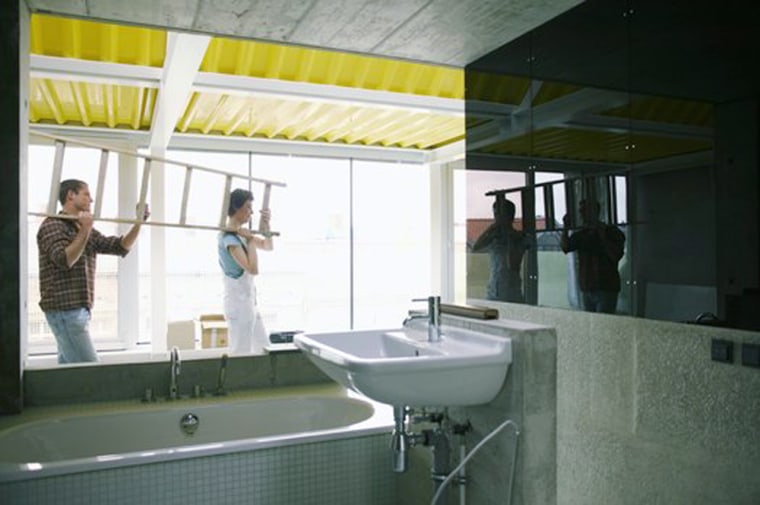Interest rates are up, the real estate boom has petered out, and so, it appears, has the remodeling frenzy.
In 2001, U.S. homeowners spent $104.6 billion on remodeling projects, estimates Harvard's Joint Center for Housing Studies. By the end of 2005, spending had risen to $149.5 billion — an increase of 43 percent over four years.
"It was the stars aligning," says Kermit Baker, director of the remodeling futures program at JCHS. "Financing costs were very low for people who were choosing to finance a project. Putting some money in your home seemed like a fun way to spend money but also a good investment."
But according to JCHS, renovation spending slowed considerably in the first quarter of 2006, growing just 4.5 percent over the prior 12 months. Home equity loans, a major financing vehicle for Americans looking to upgrade their properties, became more expensive. And the real estate market softened — considerably, in some areas. No longer can home owners slap improvements onto their properties, secure in the knowledge that they will recoup that money, and maybe substantially more, when it comes time to sell.
Under these circumstances, it's worth taking a closer look at remodeling investments, and how much of a return you can really expect to get on them.
There are plenty of ways to alter a home, from simple improvement projects to gilding-the-lily additions. Should you pay for a kitchen overhaul, adding an island, granite countertops and stainless-steel appliances? Or would you be better off painting the room and sticking new doors on the cabinets? Will a new deck raise the value of your home or simply be a perk you enjoy as long as you live in the house?
Every year for nearly two decades, Remodeling magazine has published a survey detailing how much money home owners in different parts of the country can expect to recoup from renovation investments. From replacing the siding with fancier material to adding on a lavish new master suite, the report details costs and returns for more than a dozen projects.
Doing a midrange bathroom remodel or a high-end siding replacement can get Americans back the most money on average, according to Remodeling's 2005 Cost vs. Value Report. Once they sell, home owners can expect to recoup an average of 102.2 percent of their investment for a midrange bathroom renovation and 103.6 percent for siding replacement. Plus, the owners will probably be able to enjoy the upgrades for a while.
Those numbers can be much higher — and also dramatically lower. In the western U.S., that bathroom renovation can bring in 112 percent of the original investment, according to the study. But around the country, a home owner will only get back about 74 percent, on average, of the cost of a new home office.
And just because you spend more doesn't mean you will get back a higher percentage of your money later. For an upscale kitchen makeover, which involves installing custom cherry cabinets and other luxurious amenities, the average recouped value is lower (about 85 percent) than for a minor kitchen remodeling project (98.5 percent), which is much less extensive and expensive.
And if you're looking to get your money back when you sell, it's a good idea to avoid the unusual.
"Kitchens generally tend to recoup their cost, and bathrooms too," says Delores Conway, director of the Casden Real Estate Economics Forecast at the USC Lusk Center for Real Estate. "Those are widely appealing to the marketplace, and they tend to be more standard in form. Things that are very idiosyncratic and are customized to the home owners' individual tastes ... don't appeal to a wider audience."
That can include wine cellars, home theaters, au pair living suites and other fancy add-ons. Some buyers may see them as fabulous extras, but others may see them as unnecessary and not be willing to pay a premium for them.
"With putting in a fancy swimming pool or tennis court or something like that," Baker says, "some buyers might want it. But other buyers think it's a liability."
Your potential return often depends on the regional market, the neighborhood and the characteristics of the individual home.
"If I live in a neighborhood that has homes that routinely expect to see two-and-a-half or three baths, and my home has one-and-a-half baths, by adding that second bath, I'm going to get a phenomenal return," Baker says. "On the other hand, if I have four baths and I add a fifth, I'm probably not going to get much return at all."
Such factors are worth considering carefully, since remodeling can cost a chunk of change — that upscale kitchen renovation costs more than $81,000, on average, according to Remodeling. Adding on an upscale master suite can set you back nearly $138,000.
"It's probably not a good idea to pull equity out of your home if you plan on selling in less than three years," Conway says. "It's not this white-hot market anymore. Houses stay on the market longer, you have fewer buyers, and having that price leverage is very important. Price really appeals to the market the most."
